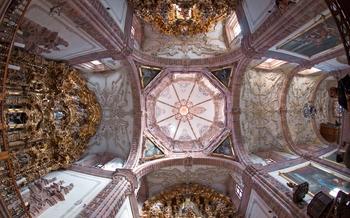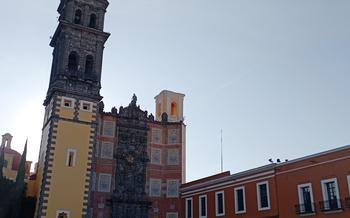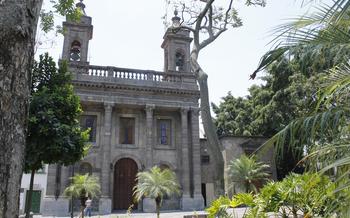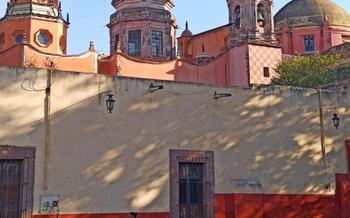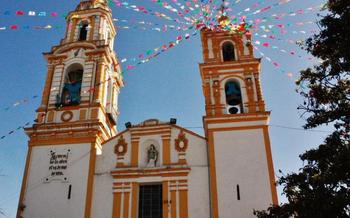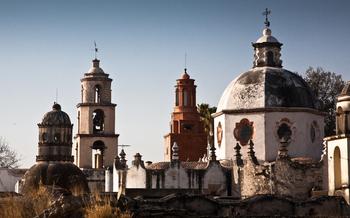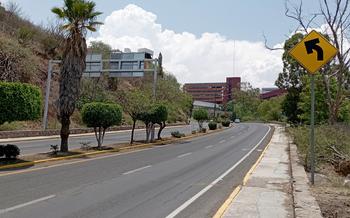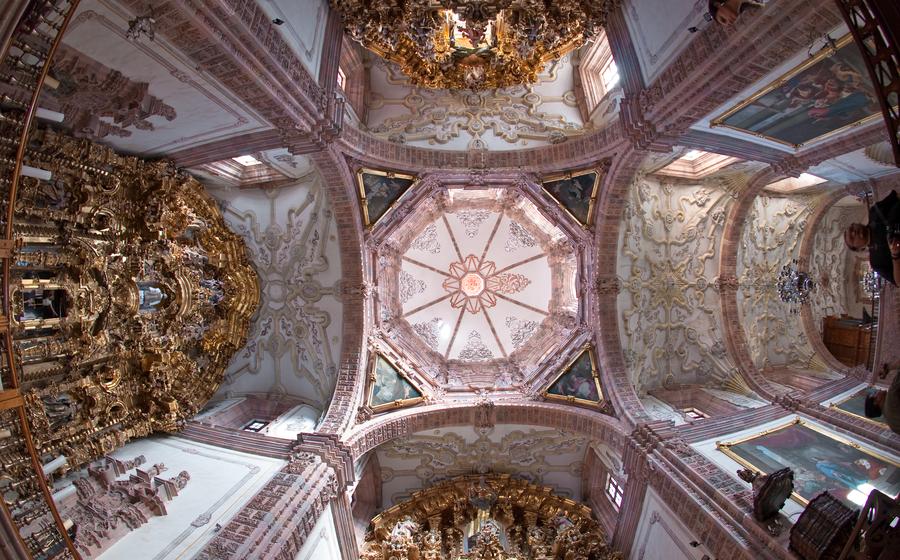
Templo La Valenciana
- Templo La Valenciana: A Baroque Masterpiece in Guanajuato
- Intricate Façade: A Symphony of Stone
- Majestic Dome: A Soaring Symbol of Faith
- Lavish Interior: A Treasure Trove of Art
- Altarpieces: Masterpieces of Religious Art
- Capilla de la Virgen de la Valenciana: A Sacred Space
- The Mining Legacy: A Path to Prosperity
- Pilgrimages and Festivals: A Celebration of Faith
- Guided Tours: Unveiling the Temple's Secrets
- Photography Tips: Capturing the Temple's Beauty
- Accessibility: Ensuring an Inclusive Experience
- Dress Code: Respecting the Sacred Space
- Local Eateries: A Taste of Guanajuato's Cuisine
- Insider Tip: Discovering Hidden Gems
Templo La Valenciana: A Baroque Masterpiece in Guanajuato
In the heart stands the magnificent Templo La Valenciana, a Baroque masterpiece that epitomizes the fusion of European and Mexican artistic traditions. This iconic landmark, constructed in the 18th century, is a testament to the architectural prowess and religious devotion that characterized this era. The temple, dedicated to the Virgen de la Valenciana, is not only a stunning work of art but also a symbol of the city's mining legacy and spiritual fervor. As you step into this sacred space, prepare to be awestruck by its intricate façade, majestic dome, lavish interior, and profound cultural significance.
Intricate Façade: A Symphony of Stone
The façade of the Templo La Valenciana is a masterpiece of Baroque architecture, showcasing intricate carvings and sculptures that tell a captivating story in stone. Every inch of the façade is adorned with elaborate ornamentation, from the grand columns and pilasters to the delicate moldings and cornices.
The detailed carvings depict scenes from the Bible, including the life of Christ, the Virgin Mary, and various saints. These intricate sculptures bring the biblical narratives to life, creating a visual feast that invites contemplation and inspiration.
The symbolism embedded in the façade is profound and multifaceted. Each element, from the smallest detail to the grandest sculpture, holds a deeper meaning, reflecting the religious beliefs and cultural heritage of the time. The façade becomes a canvas on which the story of faith and devotion is told, captivating the hearts and minds of all who behold it.
The influence of European Baroque style is evident in the façade's exuberant ornamentation and dynamic composition. The fusion of European artistic traditions with local craftsmanship resulted in a unique and awe-inspiring masterpiece that stands as a testament to the artistic prowess of the era.
Majestic Dome: A Soaring Symbol of Faith
The Templo La Valenciana's dome stands tall and proud, an architectural masterpiece that reflects the grandeur of Baroque design. Its impressive dimensions, measuring 30 meters in diameter and 48 meters in height, make it a prominent landmark that can be seen from afar. The dome's architectural significance lies in its intricate design, which incorporates elements from both the Byzantine and Renaissance styles. The combination of curved arches, ribbed vaults, and pendentives creates a harmonious effect, while the use of domes within domes adds depth and complexity to the structure.
Ornamentation plays a vital role in enhancing the dome's visual appeal. Multi-colored tiles, arranged in intricate patterns, adorn the exterior, creating a vibrant and eye-catching display. The tiles depict various biblical scenes and symbols, adding a layer of religious symbolism to the dome's design. Additionally, the dome is adorned with numerous sculptures and statues, which depict angels, saints, and other celestial figures. These sculptures add a touch of divinity to the dome, emphasizing its religious significance.
In religious architecture, the dome holds a profound symbolic meaning. It represents the heavens, the abode of God, and is often used to symbolize the aspiration of the human soul towards the divine. In the case of the Templo La Valenciana, the dome's soaring height and intricate design serve as a reminder of the grandeur and majesty of God. It invites the faithful to contemplate the heavens and to seek a deeper connection with the divine realm.
Lavish Interior: A Treasure Trove of Art
The interior of the Templo La Valenciana is a testament to the grandeur and opulence of Baroque architecture. Every inch of the walls, ceiling, and altars is adorned with intricate frescoes, paintings, and sculptures, creating a symphony of visual splendor.
The frescoes, executed by the talented Miguel Cabrera, depict scenes from the Bible and the lives of saints, bringing the sacred narratives to life with vibrant colors and expressive brushstrokes. The paintings, by renowned artists such as José de Alcíbar, showcase the mastery of the Baroque style, with their dramatic lighting, rich hues, and lifelike figures.
The altars, adorned with gleaming gold leaf and intricate carvings, are a feast for the eyes. Each altarpiece is a masterpiece of religious art, featuring elaborate carvings depicting biblical scenes and the lives of saints. The main altarpiece, dedicated to the Virgin of La Valenciana, is a breathtaking spectacle, with its towering columns, delicate tracery, and radiant golden rays.
The overall effect of the interior is one of awe and wonder. The harmonious blend of art, architecture, and religious symbolism creates a sacred space that invites contemplation and devotion. Whether you are a history buff, an art enthusiast, or simply a traveler seeking beauty and inspiration, the interior of the Templo La Valenciana is a must-see.
Altarpieces: Masterpieces of Religious Art
The Templo La Valenciana's interior is adorned with a series of elaborate altarpieces that are considered masterpieces of religious art. These intricate structures, crafted from wood and adorned with gilt work, depict scenes from the Bible and feature statues of saints and angels.
Each altarpiece is a unique work of art, showcasing the skill and artistry of the craftsmen who created them. The attention to detail is remarkable, with every element carefully carved and adorned. The result is a stunning visual display that adds to the grandeur and opulence of the temple's interior.
One of the most notable altarpieces is the main altarpiece, which dominates the sanctuary. This magnificent structure, which stands over 30 feet tall, is dedicated to the Virgin of La Valenciana. It features a central niche that houses a statue of the Virgin, flanked by statues of saints and angels. The altarpiece is elaborately carved and decorated with gilt work, creating a dazzling effect that draws the eye.
The other altarpieces in the temple are equally impressive, each dedicated to a different saint or theme. The Altar of the Holy Family, for example, depicts the Holy Family with Jesus, Mary, and Joseph. The Altar of the Crucifixion portrays the crucifixion of Jesus, while the Altar of the Resurrection celebrates His resurrection.
These altarpieces are not merely decorative elements; they serve as powerful reminders of the sacred stories that form the foundation of the Catholic faith. They invite visitors to contemplate the life and teachings of Jesus Christ and to seek inspiration and guidance from the saints. Standing before these masterpieces, one can't help but be awed by the beauty and craftsmanship they embody.
Capilla de la Virgen de la Valenciana: A Sacred Space
Within the Templo La Valenciana, the Capilla de la Virgen de la Valenciana holds a special place in the hearts of the people of Guanajuato. The chapel serves as a pilgrimage site, attracting countless devotees who seek solace, guidance, and blessings from the Virgin.
The history of the chapel is deeply intertwined with the story of the Valenciana mine. As the mine flourished, the miners and their families sought divine protection and guidance. In response to their prayers, the image of the Virgin of La Valenciana was brought to the chapel, becoming a symbol of hope and faith for the mining community.
Over the years, the chapel has undergone several renovations and expansions, reflecting the growing devotion to the Virgin. Its interior is adorned with intricate carvings, colorful frescoes, and opulent altars, creating an awe-inspiring atmosphere that invites contemplation and prayer.
The annual pilgrimage to the Templo La Valenciana, held on December 8th, is a testament to the enduring devotion to the Virgin of La Valenciana. Thousands of pilgrims from across the region converge on the temple, participating in colorful processions, traditional dances, and heartfelt prayers. The festivities culminate in a grand mass and a solemn procession, where the image of the Virgin is carried through the streets of Guanajuato, showering blessings upon the faithful.
The Capilla de la Virgen de la Valenciana is not just a religious site but also a symbol of Guanajuato's rich cultural heritage. It represents the deep faith, resilience, and devotion of the Mexican people, making it a must-visit destination for anyone seeking spiritual enlightenment and a deeper connection with the history and culture of Guanajuato.
The Mining Legacy: A Path to Prosperity
Guanajuato's silver veins ran deep, and the discovery of the Valenciana mine in 1760 unleashed a torrent of wealth that would transform the city into one of the richest in New Spain.
The mine, owned by Antonio de Obregón y Alcocer, yielded an astonishing amount of silver, propelling Guanajuato to the forefront of Mexico's mining industry. The city's population swelled with miners, merchants, and fortune seekers, drawn by the allure of the silver rush.
The Valenciana mine became a symbol of Guanajuato's prosperity, its silver fueling the construction of grand haciendas, opulent churches, and civic buildings. The city's newfound wealth also attracted artists, intellectuals, and skilled craftsmen, who left their mark on Guanajuato's cultural and architectural landscape.
The mining boom not only enriched Guanajuato but also had a profound impact on the development of Mexico as a whole. The silver from the Valenciana mine helped to finance the country's independence struggle and contributed to the establishment of the Mexican nation.
Today, the Valenciana mine stands as a testament to the transformative power of mining in Guanajuato. Although the mine is no longer in operation, its legacy lives on in the city's rich cultural heritage and the enduring beauty of its colonial architecture.
Pilgrimages and Festivals: A Celebration of Faith
The Templo La Valenciana is not only a testament to architectural and artistic mastery but also a site of profound religious significance. Each year, thousands of pilgrims flock to the temple to pay homage to the Virgin of La Valenciana, a revered figure deeply embedded in the cultural and religious fabric of Guanajuato.
The annual pilgrimage to the Templo La Valenciana is a spectacle to behold. Devotees from far and wide embark on a journey of faith, converging at the temple to celebrate the Virgin's feast day. The air crackles with anticipation as colorful processions wind through the streets, accompanied by the rhythmic beats of traditional music and the joyous laughter of pilgrims.
During the festivities, the temple transforms into a vibrant tapestry of colors and sounds. Elaborate altars adorned with flowers and candles illuminate the sacred space, while the faithful offer prayers and songs in honor of the Virgin. The atmosphere is palpable, filled with a sense of devotion and camaraderie that transcends cultural and geographical boundaries.
The pilgrimage to the Templo La Valenciana is not merely a religious event but also a celebration of Guanajuato's rich cultural heritage. Traditional dances, music, and food converge to create a vibrant spectacle that showcases the region's unique identity. Visitors can immerse themselves in the festivities, savoring the flavors of local cuisine, admiring the intricate costumes of the dancers, and experiencing the infectious energy that permeates the air.
Whether you are a devout pilgrim or a curious traveler, the pilgrimage to the Templo La Valenciana is an unforgettable experience that offers a glimpse into the heart and soul of Guanajuato. It is a celebration of faith, culture, and community, where the sacred and the secular intertwine to create a tapestry of traditions that has stood the test of time.
Guided Tours: Unveiling the Temple's Secrets
To fully appreciate the Templo La Valenciana's rich history and architectural marvels, consider embarking on a guided tour. Knowledgeable and passionate guides will lead you through the temple's sacred spaces, explaining the significance of each detail and providing insights into its construction, symbolism, and religious importance. Immerse yourself in the stories behind the intricate carvings, frescoes, and altarpieces, and gain a deeper understanding of the Baroque style that defines this architectural masterpiece. Guided tours offer a personalized and enriching experience, allowing you to uncover the hidden secrets of the Templo La Valenciana and its role in the cultural and religious heritage of Guanajuato.
Photography Tips: Capturing the Temple's Beauty
The Templo La Valenciana is a photographer's paradise, offering endless opportunities to capture its stunning beauty. For the best results, plan your visit during the golden hours of sunrise or sunset, when the warm light casts a magical glow on the temple's façade. Use a wide-angle lens to capture the grandeur of the structure and tripod to steady your camera, especially for low-light shots. Experiment with different angles to showcase the intricate details, such as the carved reliefs and sculptures adorning the exterior. Remember to respect the sanctity of the religious space and avoid using flash photography inside the temple.
Accessibility: Ensuring an Inclusive Experience
The Templo La Valenciana is committed to providing an inclusive experience for all visitors, regardless of their physical abilities. Wheelchair ramps and designated parking areas are available to ensure easy access to the temple. For visitors with visual impairments, audio guides are available to narrate the temple's history, architecture, and religious significance. The staff at the temple is also trained to assist visitors with disabilities, providing any necessary assistance to make their visit as enjoyable and fulfilling as possible.
Dress Code: Respecting the Sacred Space
When visiting the Templo La Valenciana, it is important to dress appropriately, showing respect for the sacred nature of the site. While there is no strict dress code, modest attire that covers the shoulders and knees is generally recommended. Avoid wearing shorts, tank tops, or excessively revealing clothing. The aim is to maintain a solemn and respectful atmosphere within the temple.
Remember, the Templo La Valenciana is not only a historical and architectural marvel but also an active place of worship for the local community. Dressing respectfully demonstrates your consideration for their religious beliefs and practices. It also contributes to the overall ambiance of reverence and tranquility within the sacred space.
By adhering to the dress code, you not only blend in with the local worshippers but also set a positive example for other visitors. It is a simple yet meaningful way to honor the sanctity of the temple and show respect for the religious traditions of the people of Guanajuato.
Local Eateries: A Taste of Guanajuato's Cuisine
A visit to the Templo La Valenciana offers a chance to savor the culinary delights of Guanajuato. In the vicinity of the temple, visitors can find an array of restaurants and cafes that offer a tempting array of traditional Mexican dishes and local specialties. From authentic street food stalls to charming cafes, there are options to suit every taste and budget.
One must-try dish in Guanajuato is the enchiladas mineras, a local specialty that features corn tortillas filled with cheese, potatoes, and a tangy red sauce. Another popular dish is the pozole, a hearty soup made with hominy, meat, and a variety of spices. For a lighter meal, try the sopes, which are thick corn tortillas topped with beans, cheese, and various other ingredients.
For those with a sweet tooth, Guanajuato offers a variety of tempting desserts, including the cajeta, a caramel sauce made from goat's milk, and the chongos zamoranos, a sweet treat made from curdled milk and brown sugar.
To fully immerse in the local culture, be sure to visit the Mercado Hidalgo, a bustling market that offers a wide array of fresh produce, local delicacies, and traditional crafts. Here, visitors can sample exotic fruits, savor traditional Mexican street food, and pick up souvenirs to remember their trip.
Insider Tip: Discovering Hidden Gems
Venturing beyond the Templo La Valenciana, Guanajuato offers a treasure trove of hidden gems waiting to be discovered. Take a leisurely stroll through the city's charming cobblestone streets, where colorful buildings, quaint shops, and inviting cafes line the way. Immerse yourself in the vibrant local culture and soak in the city's unique atmosphere.
In the heart of Guanajuato, the Templo de San Cayetano is another architectural marvel that deserves a visit. This 18th-century church boasts an elaborate Baroque façade and a stunning interior adorned with intricate frescoes and gold leaf detailing.
For a deeper dive into Guanajuato's rich history, consider visiting the Museo de las Momias (Mummy Museum). This fascinating museum showcases a collection of naturally mummified bodies, providing a unique glimpse into the city's past.
Don't miss the opportunity to savor the delectable flavors of Guanajuato's cuisine. From traditional Mexican dishes like enchiladas and pozole to local specialties like cajeta (goat's milk caramel), there's something to satisfy every palate. Indulge in a culinary adventure at one of the many nearby restaurants or cafes, and let the flavors transport you to the heart of Mexico.
